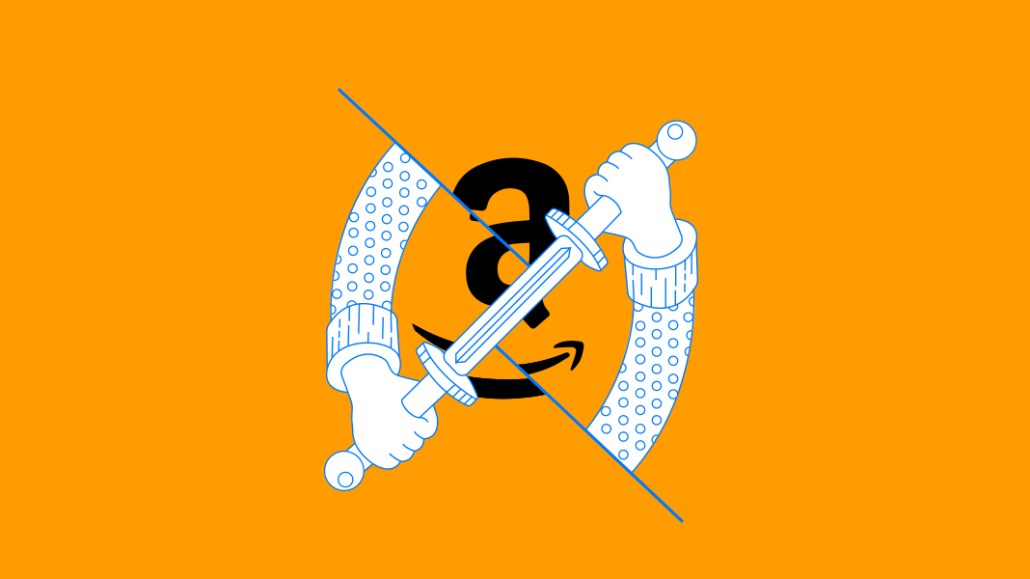Join us Dec. 1-3 in New Orleans for the Digiday Programmatic Marketing Summit
‘Completely fell off a cliff’: Amazon Onsite Associates has gotten bumpy for some participating publishers

Last year, a small collection of publishers were mulling the exciting — and risky — prospect of growing their commerce revenue by publishing product guides and recommendations directly inside Amazon, through an Amazon affiliate program called Onsite Associates.
One year later, many are regretting the effort they put into it.
Following a number of tests that participants say Amazon has not adequately explained, Onsite Associates revenue for many participants has fallen precipitously, in some cases by more than 90%, according to sources at nine different publishers that participate in the program.
Some of those sources, who said they were generating well over $100,000 per month through the program earlier this year, have been forced to cut back on producing or formatting content for it. Many publishers that hired staff specifically to manage and grow Onsite Associates revenue have had to find different roles for those people, and sources at two participating publishers said they are now weighing whether to lay those people off.
A source at one participating publisher, which has seen their Onsite Associates revenue drop by more than 70% this year, may abandon the program unless they experience a major surge in revenue in the fourth quarter, a source inside that publisher said.
“It just completely fell off a cliff and it hasn’t come back,” said a source at a fourth title, which had seen Onsite Associates quickly grow into a million-dollar source of revenue before it dropped, that source said, to “effectively zero” in the past three months.
“It’s been super frustrating,” that source added. “Amazon has not provided any real visibility into why it’s happened, or what we can do to fix it.”
Onsite Associates is effectively a platform-native version of the affiliate programs many publishers have been developing for the past several years. If an Amazon site visitor finds a product on a participating publisher’s guide, adds it to their cart and buys it, the publisher gets a cut of the sale; the size of the commission varies by product category.
The collapsing revenue for some feels at odds, the sources said, with the apparent health of the program. Since its invite-only launch two years ago, Onsite Associates has expanded from 30 U.S. publishers to around 200, and recently launched in different markets, including the U.K. There are now thousands of publisher-supplied guides seeded across Amazon’s sites, sources estimate, helping Amazon users evaluate everything from espresso machines to hair dryers to running shoes.
And not every publisher has seen such dramatic slides. Two sources contacted for this story said they were earning more now from Onsite Associates than they did at the start. Another, which saw its revenues drop 30% after significantly expanding the kinds of content it produced, has simply scaled back its output.
But the revenue from the program is so erratic that some publishers now say they can no longer forecast from it. One source said that they have trouble including Onsite Associates in their budgeting forecasts because the revenue is so unpredictable.
“We have to look at it week by week,” a third source said.
In every case, the participants say the changes — much like the cuts Amazon made to its flagship affiliate program, Amazon Associates, earlier this spring — are just another reminder that partnerships with Amazon should be approached with caution.
“From day one, we knew: We can’t make this a core component [of our business],” said a source at one publisher, which now counts Onsite Associates for close to 20% of its commerce revenue.
“They always cut their rates,” added that source, who said that their Onsite Associates revenue has fallen by close to 30% over the past four months. “So, long term, I expect the same thing out of OSP. I just don’t know if it’s six months or three years from now.”
Reached for comment, Amazon said it did not comment on its business relationships.
Publishers’ level of frustration seems to mirror how much time and energy they’ve invested in Onsite Associates. While many got started with the program by simply reformatting or modifying existing commerce content, others began developing content specially for Onsite Associates.
Much like the short-form videos publishers produced — and failed to monetize — especially for Facebook, Onsite Associates participants who built content specifically for the program have been frustrated to discover that content made for the platform didn’t make money and they cannot monetize it using their other commerce content programs and arrangements, two sources said.
“What has a lot of search volume on OSP may not have much search volume on Google,” one source said.
Those publishers also had to deal with what they described as an opaque, confusing content approval process. Each guide that appears on Associates needs to be approved, and the approval process for each guide can often take weeks. The guides that don’t get approved are often rejected for reasons that are unclear, those sources said.
The content that does get approved, in turn, is vulnerable to frequent tests Amazon runs on the program. As Onsite Associates has grown, sources said Amazon has begun subjecting it to lots of different tests in an effort to maximize its effectiveness, not just on its own but relative to other Amazon products, such as its own ad units or Amazon’s Choice widgets.
Those tests, which Amazon almost never warns publishers are coming, would often cause significant drops in revenue. In January, Amazon ran a test where it took Onsite Associates content out of its mobile search results, a move that immediately caused problems. “You notice when your clicks drop by 70%,” one participant said.
But perhaps the biggest point of contention, sources said, was a familiar one for any publisher that has worked with Amazon: A lack of communication.
All nine sources contacted for this story described being frustrated by the lack of information that Amazon would provide on a number of topics, from how to improve conversion rates to drops in revenue, not just from reps but from the dashboards that provide analytics on the content inside Onsite Associates. An Amazon spokesperson said it was planning to improve the insights it offered participants on the performance and eligibility of content, but did not offer details or a timetable.
While they wait on those improvements, some of the sources at publishers who have seen their revenue crater said they feel more that they have been used. “Amazon is not a partner,” one source said. “They’ll play nice if you have something they want.
“We’re filling a gap for them right now,” that source added. “As soon as we’re out of filling this gap for 2020 — they’ll pivot and leave us behind.”
More in Media

WTF are synthetic audiences?
Publishers and brands are using AI to create a copy of audience behavior patterns to conduct market research faster and cheaper.

Forbes launches dynamic AI paywall as it ramps up post-search commercial diversification plans
For the latest Inside the publisher C-Suite series, Digiday spoke to Forbes CEO Sherry Phillips on its AI-era playbook, starting with its AI-powered dynamic paywall to new creator-led commercial opportunities.

Creators embrace Beehiiv’s push beyond newsletters
Creators are embracing Beehiiv’s new website, product and analytics tools to help them grow beyond the competitive newsletter space.






